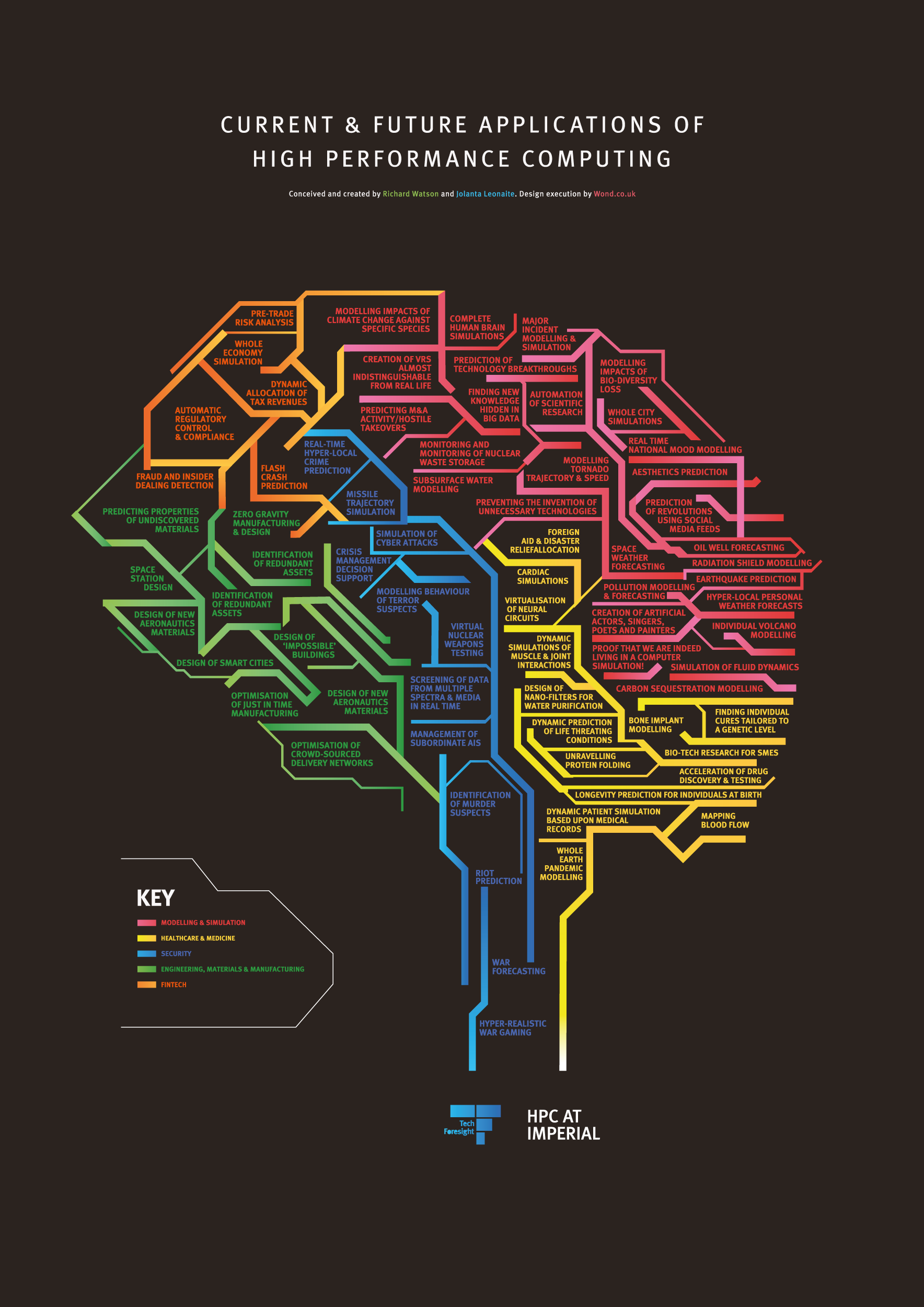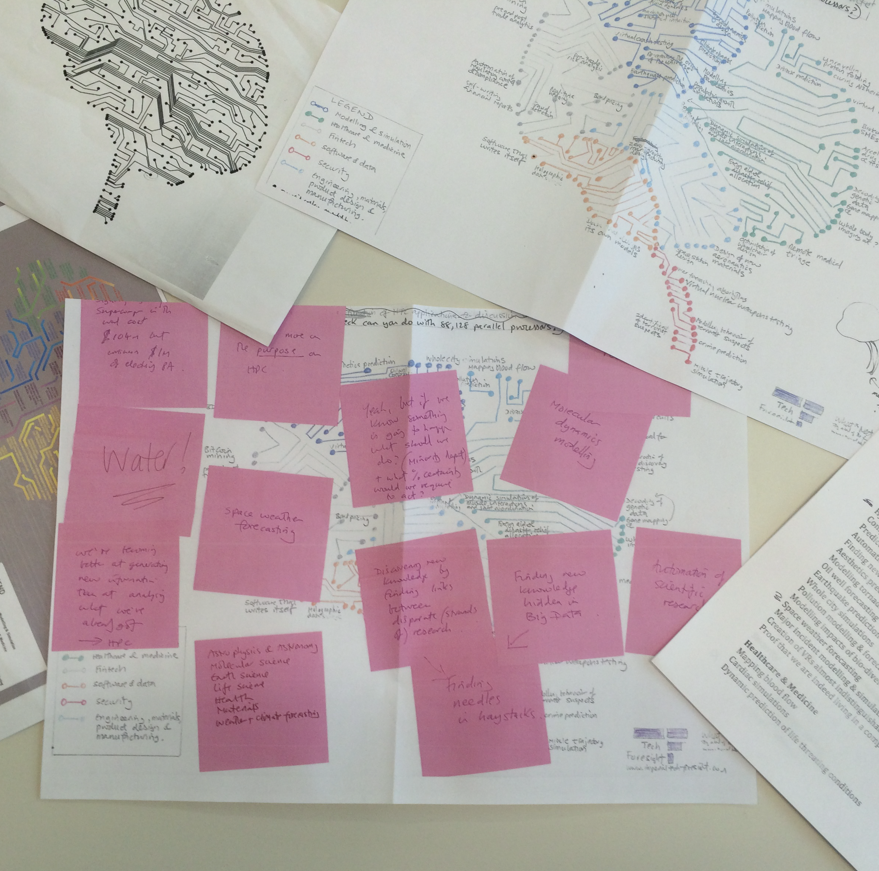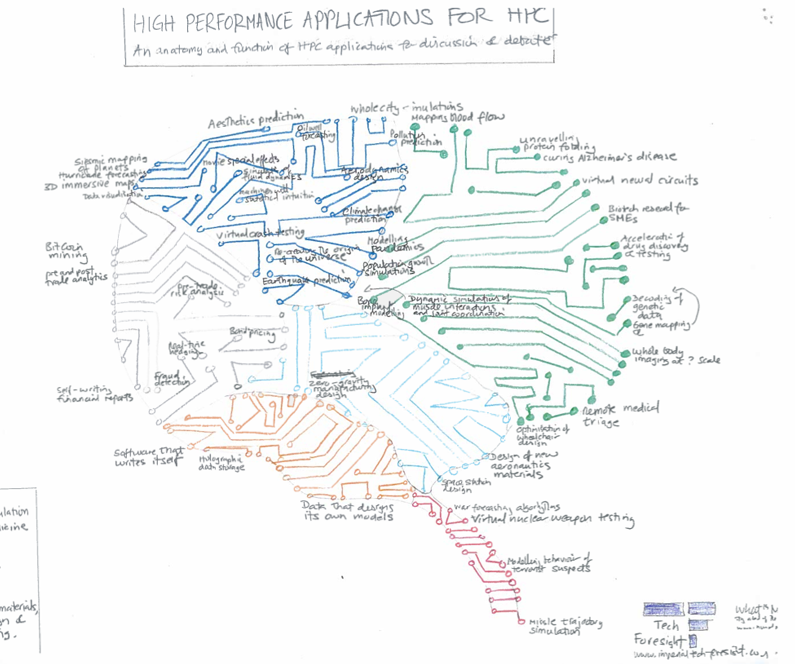So here’s a new roadmap showing how HPC (High Performance Computing or Super Computing as it’s sometimes known) is currently being used and what HPC might be capable of in the distant future (unspecified).
There are five key categories of applications: Modelling & Simulation, Healthcare & Medicine, Security, Fintech and Materials, Manufacturing & Engineering. We had Data in there too in the beginning, but removed it because most applications seemed to be subsets of the other categories.
In an ideal graphic the various entries would connect. For example, design of nano-water filters is materials & engineering, but it’s also modelling and it’s healthcare.
There are a couple of jokes on the map to keep people on their toes (or maybe not!) and the point of the map is dead simple. It’s intended to stimulate discussion about what HPC is capable of and where HPC might be heading (my personal favourite entry is aesthetics prediction btw).
The entries are all largely tech-push of course. In the real world you’d need to overlay things like energy, security, privacy, regulation and human psychology to get a clearer picture of what’s next, but it’s a start. As far as we can tell it’s also far better than anything currently out there in terms of info-graphics about HPC.
The main audience is obviously the global HPC community, but hopefully it will appeal to anyone interested in computing, Big Data, predictive analytics and perhaps machine learning and AI. (BTW, why HPC isn’t called Big Computing is beyond some of us!)
Below are a few pictures showing the development of the map, which originally started off in the shape of a question mark with the really big question being either where is this all going or what is this all really for?
The really interesting category to our collective mind at Tech Foresight is simulation and modelling. It brings up ethical and even philosophical questions about how simulations impact reality. For example, if you have data that suggests something will happen, what level of certainty would you require to then act and where is free will and human agency in all this?
BTW, thanks to Jolanta Leonaite, Gavin Bravery, Prof. Peter Haynes and Prof. Nick Jennings for their input.
Nice bit of coverage in Forbes already too. @forbes
Modelling & Simulation
Modelling impacts of climate change against specific species
Predicting M&A activity/hostile takeovers
Radiation shield modelling
Monitoring and monitoring of nuclear waste storage
Carbon sequestration modelling
Simulation of fluid dynamics
Subsurface water modelling
Prediction of technology breakthroughs
Preventing the invention of unnecessary technologies
Creation of artificial actors, singers, poets and painters
Individual volcano modelling
Real time national mood modelling
Hyper-local personal weather forecasts
Complete human brain simulations
Prediction of revolutions using social media feeds
Automation of scientific research
Finding new knowledge hidden in big data
Aesthetics prediction
Modelling tornado trajectory & speed
Oil well forecasting
Earthquake prediction
Whole city simulations
Pollution modelling & forecasting
Modelling impacts of bio-diversity loss
Space weather forecasting
Major incident modelling & simulation
Healthcare & Medicine
Mapping blood flow
Cardiac simulations
Dynamic prediction of life threating conditions
Whole earth pandemic modelling
Unravelling protein folding
Acceleration of drug discovery & testing
Foreign aid & disaster relief allocation
Dynamic simulations of muscle & joint interactions
Bone implant modelling
Longevity prediction for individuals at birth
Design of nano-filters for water purification
Dynamic patient simulation based upon medical records
Fintech
Pre-trade risk analysis
Fraud and insider dealing detection
Automatic regulatory control & compliance
Dynamic allocation of tax revenues
Flash crash prediction
Whole economy simulation
Engineering, materials & manufacturing
Space station design
Design of new aeronautics materials
Zero gravity manufacturing & design
Predicting properties of undiscovered materials
Design of smart cities
Optimisation of crowd-sourced delivery networks
Design of ‘impossible’ buildings
Security
Riot prediction
War forecasting
Virtual nuclear weapons testing
Real-time hyper-local crime prediction
Hyper-realistic war gaming
Simulation of cyber attacks
Missile trajectory simulation
Crisis management decision support





